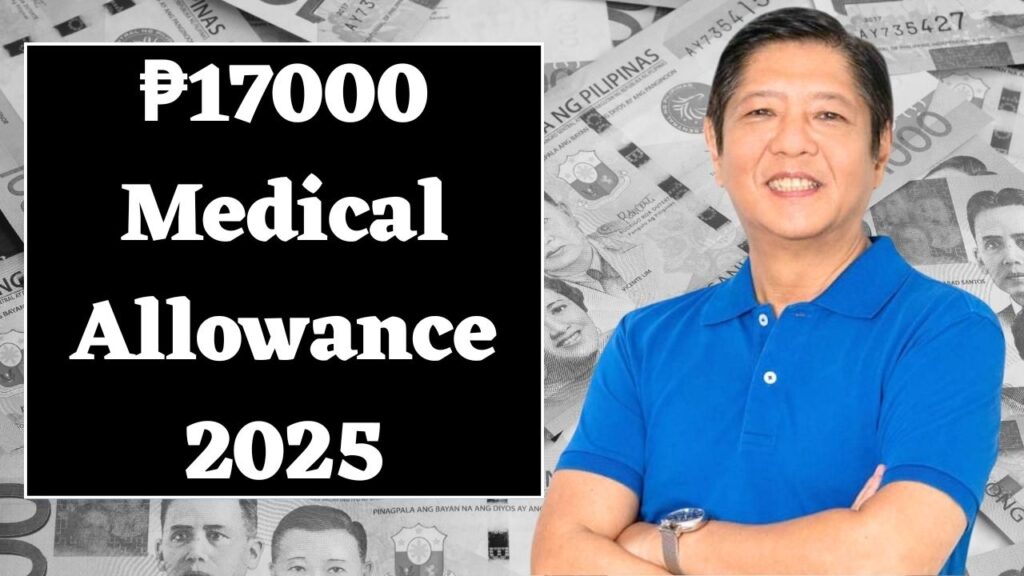₱17000 Medical Allowance 2025: Starting in 2025, the Philippine government will implement a ₱17000 annual medical allowance for eligible public sector employees. This initiative, established under Executive Order No. 64 and guided by Budget Circular 2024-6 from the Department of Budget and Management (DBM), is designed to assist government workers in covering essential healthcare costs.
Employees in National Government Agencies (NGAs), State Universities and Colleges (SUCs), Government-Owned and Controlled Corporations (GOCCs), Local Government Units (LGUs), and Local Water Districts can utilize this allowance for Health Maintenance Organization (HMO) enrollment or direct medical expense reimbursement.
This financial support aligns with the government’s broader mission to improve employee welfare, ensuring access to healthcare services while reducing out-of-pocket medical expenses. Below is a comprehensive breakdown of the program, including eligibility, usage, distribution, and long-term advantages.
Overview of ₱17000 Medical Allowance
The ₱17000 Medical Allowance is a financial aid program that supports government employees in managing healthcare expenses. With rising medical costs, this initiative ensures that public sector workers can receive essential medical care without financial strain. Beneficiaries can opt to allocate the funds towards HMO membership or claim reimbursement for eligible medical costs.
Key Details
| Category | Details |
| Allowance Amount | ₱17000 per year per eligible employee |
| Implementation Year | 2025 |
| Eligible Employees | Regular, casual, contractual, appointive, and elective officials |
| Usage Options | HMO enrollment or medical expense reimbursement |
| Covered Sectors | NGAs, SUCs, GOCCs, LGUs, Local Water Districts |
| Official Guidelines | Budget Circular 2024-6 |
This initiative aims to reduce healthcare expenses and foster a healthier, more efficient government workforce.

Who Qualifies for the Medical Allowance?
The government has ensured broad eligibility to cover various employment types in the public sector.
Eligible Employees
- Regular Employees – Permanent, full-time government workers.
- Casual and Contractual Employees – Non-permanent personnel hired through government contracts.
- Appointive and Elective Officials – Government officials appointed or elected to positions.
- LGU and Local Water District Employees – Employees working in municipal, provincial, and barangay offices, as well as in water district management.
Ineligible Employees
Certain personnel categories do not qualify for the benefit:
- Job Order (JO) Workers – Temporary or seasonal hires.
- Contract of Service (COS) Employees – Workers hired for specific projects without an employer-employee relationship under civil service rules.
How Can Government Employees Use the ₱17000 Medical Allowance?
Eligible employees can choose between two primary options for utilizing their medical allowance:
1. HMO Enrollment
The allowance can be used to enroll in an HMO, granting access to various healthcare services, including:
- Doctor consultations
- Laboratory tests
- Hospitalization
- Emergency medical care
Government agencies may facilitate HMO selection and enrollment for ease of access.
2. Direct Reimbursement for Medical Expenses
Alternatively, employees may seek reimbursement for out-of-pocket medical expenses, such as:
- Doctor’s consultation fees
- Prescription medications
- Laboratory tests
- Hospital bills
To claim reimbursement, employees must submit receipts or other proof of medical expenses to their respective agencies.
Distribution of ₱17000 Medical Allowance
The DBM has set up a structured system to ensure a smooth and transparent allocation of the allowance. Key aspects of distribution include:
- Employees may receive the allowance through HMO partnerships or as direct reimbursement.
- Proof of expenses (receipts, invoices) is required for reimbursement claims.
- The benefit is non-transferable and must be used by the eligible employee.
- Government agencies will oversee the processing of claims to ensure efficient disbursement.
Covered Medical Expenses
The government has outlined specific categories of medical expenses that qualify for reimbursement.
| Category | Examples of Covered Expenses |
| Medical Check-ups | General consultations, specialist visits |
| Diagnostic Tests | X-rays, blood tests, preventive screenings |
| Hospitalization | Emergency care, surgeries, hospital stays |
| Medications | Prescription drugs, essential treatments |
| HMO Plan Payments | Contributions for HMO coverage |
Claims must fall within these categories to be eligible for reimbursement.
Tracking and Managing the Allowance
To maintain transparency and prevent misuse, the DBM will enforce strict monitoring measures, including:
- Annual Reports – Agencies must submit records detailing allowance distribution.
- Audits – Random and scheduled audits will be conducted to ensure compliance.
- Policy Adjustments – The government may review and adjust the allowance amount to account for inflation and rising healthcare costs.
Benefits of the Medical Allowance for Government Employees
This initiative significantly enhances the well-being of public sector workers by making healthcare services more affordable and accessible. With reduced medical costs, employees can undergo necessary treatments without financial stress, leading to:
- Improved healthcare access – Employees can seek medical attention without worrying about expenses.
- Higher job satisfaction – Reduced financial burden contributes to better work morale.
- Increased productivity – A healthier workforce enhances overall efficiency in government services.
Budget Secretary Amenah Pangandaman has emphasized that this initiative is more than just financial support—it is an investment in the well-being and effectiveness of the government workforce. By prioritizing healthcare, the Philippine government aims to create a healthier, more motivated public sector for the years ahead.
